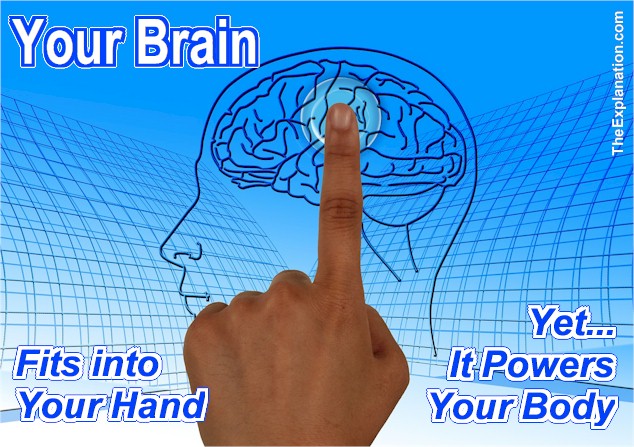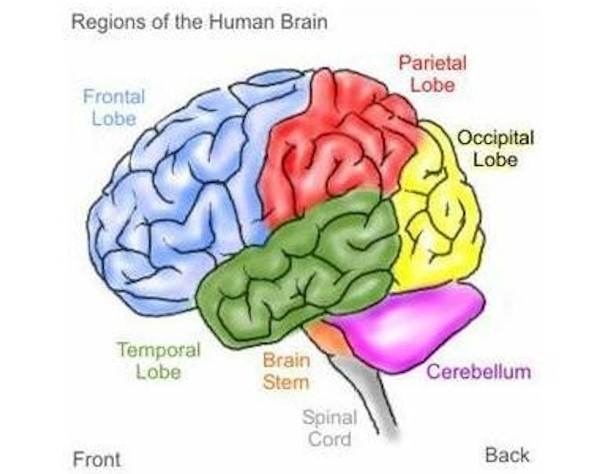The Brain … you don’t even think about it … but it is the Control Centre that allows you to function in a Human Manner. Physically it fits into your hand but Bodily it powers your Being.

The Brain … you don’t even think about it … but it is the Control Centre that allows you to function in a Human Manner. Physically it fits into your hand but Bodily it powers your Being.
Imagine.
Our next destination is a surprise: It’s the brain, figuratively and literally.
We are inside a medical imaging lab, still within the same complex as before. However, as we look around, decode the sensory input, and analyze the location, we are using our brains.
(chapter 9.1-2)
Powerful processes are occurring within this organ, which only weighs 1.4 kilograms (the same as a small hand weight). These processes result in our ability to identify the machines: a CAT scanning machine, an MRI machine, and an EEG diagnostic machine. We can also identify Galacti’s current costume as a lab coat.
More importantly, we can contemplate the question that is on our minds: What is our purpose in this lab? What are we here to learn? We can remember all the rich experiences we have had thus far.
We recall observing the moment of the Big Bang, exploring the planets, appreciating how our own Earth is tailor-made for our existence, observing the water cycle, meeting earthworms, exploring the growth and harvesting of wheat, and learning about animals’ remarkable abilities.
We can review our experiences and try to imagine future ones as we predict what we will do next and where Galacti will lead us on this tour.
All of this mental activity takes place in our brains, which form the most complex facet of the entire universe. We will explore our brains using the tools we have available, such as the imaging systems and something more. We’ll look at the figures and then examine our control center.
The control center is called the cerebral cortex, and it is the means by which we can reach answers to our main questions: Are humans equipped to perceive, think and reason? Even more importantly, if the answer is yes, then why are humans equipped to reason?
The Cerebral Cortex and the Geography of the Brain
As the technician, Galacti runs the CAT scan machine in order to help us explore the cerebral cortex, one part of an adult brain.
I volunteer to be the test subject and enter the machine to have my brain scanned so that our fellow travelers can observe it.
While Galacti does this, he provides information and statistics. There are about 100 billion neuron cells inside the brain. Compare this with the estimated 400 billion total number of
stars in the Milky Way.
These neuron cells will make up the picture of my brain scan. This figure encompasses the entire brain as a whole, but when we talk about the brain, we usually divide it into distinct parts
like our specialized CAT scan does. As the machine creates an image of my brain, it displays the cortex.
The cortex is the outer layer, which resembles a mass of unusually thick linguini. This “linguini” contains thirty billion neurons, electrical and chemical transmitters that connect via several thousands of strands forming a network of one trillion synaptic connections.
My brain activity is registering on the scan as I contemplate the number of possible neuronal circuits that brain signals can follow. Like packets of information on the internet, the number of pathways is practically limitless. This dwarfs the integrated circuits in the world’s most advanced computers.
The other portions of the brain are equally complex, yet when we think of or talk about the brain, we don’t focus on these huge numbers and the complexities they imply.
When we think about the brain, we don’t focus on the huge numbers involved and the complexities they imply. Share on XUsually, when we are presented with a description of the brain, we hear about the practical, problem-solving left hemisphere and the emotional, artsy right hemisphere. If we break down the brain structure further than the logical, how-to hemisphere and the emotional, big-picture-oriented hemisphere, we discover four lobes.
The frontal lobe, particularly the prefrontal cortex, shapes our personality and higher cognitive functions as well as our movements. It also brings forth all the social variety we see in this room alone. The parietal lobe is the sense center, which integrates information from all five senses.

A very simplistic structural view of the brain referring to the four lobe regions and the two-sided brain.
The occipital lobe allows us to recognize that the machines are white, cream-colored, or gray, and that the opening to the MRI machine is a circle. Lastly, the temporal lobe allows us to distinguish my face from another traveler’s or recognize the scenes of our hometowns being shown to us from the library of the universe.
However, these lobes take their names from the skull bones encasing them, and not from their structure or role! This proves how little we understand the brain. Humans have dissected the brain into compartments for scientific, medical, and anatomical purposes.
This practice may make labeling easier, but it gives a simplistic impression that we easily comprehend the way the brain works as a whole. In fact, for all of our progress in understanding the brain, it is still a great mystery.
Can the structure of the brain truly explain why we do what we do, how we think, why we love what we love, and why we fear what we fear? We stop to ponder this question.
Can the structure of the brain explain why we do what we do, how we think, why we love what we love, and why we fear what we fear? Share on XThis post is an excerpt from chapter 9.1-2 of Inventory of the Universe.
The Explanation Blog Bonus
WARNING: This first video about the brain contains graphic images of a human brain from a recent autopsy. Background noise is unrelated to this brain or the deceased. In this teaching video, Suzanne Stensaas, Ph.D., Professor of Neurobiology and Anatomy at the University of Utah School of Medicine, demonstrates the properties and anatomy of an unfixed brain.
There are two purposes for this video: 1) to stress the vulnerability of the brain to highlight the importance of wearing helmets, seat belts, and taking care of this very precious tissue, and 2) to use as a teaching aid for students who only have access to fixed tissue, models, and pictures.
I would add that it also becomes visibly clear that the ‘four lobes’ mentioned above are not really apparent.
This is a longer documentary about the brain a study into its central role in everything we do.
Dig Deeper into The Explanation
Online Study Courses to Uncover the Mystery of Adam and Eve’s Nakedness… with no fuss. Free video mini-course revealing the God-intended meaning of Scripture via Biblical Hebrew. It’s so easy, it’ll blow you away. Join now and add new motivation to your Bible study.
Join The Explanation Newsletter to stay informed of updates. and future events. No obligations, total privacy, unsubscribe anytime, if you want.
The Explanation series of seven books. Free to read online or purchase these valuable commentaries on Genesis 1-3 from your favorite book outlet. E-book and paperback formats are available. Use this link to see the details of each book and buy from your favorite store.

Since you read all the way to here… you liked it. Please use the Social Network links just below to share this information from The Explanation, The Brain Amazingly Small, Amazingly Powerful – Why?



Trackbacks/Pingbacks